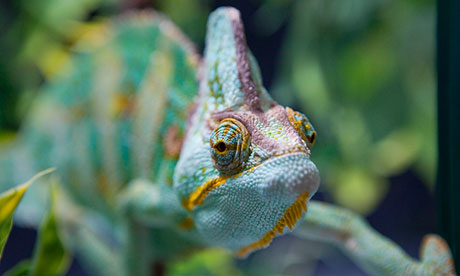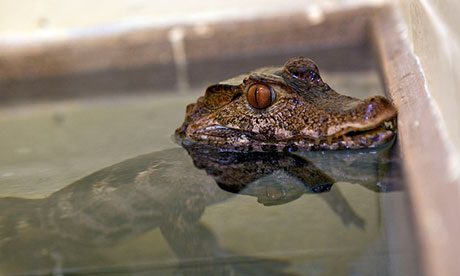 Kermit, a 2-year-old service dog trained to detect fluctuations in human blood sugar levels, helps 9-year-old Kiernan Sullivan monitor his type 1 diabetes, giving Kiernan’s parents some extra relief. Uncontrolled blood sugar levels can lead to problems such as neuropathy, limb loss and even blindness, so specially trained dogs, along with tools such as glucose monitors that help keep blood sugar levels within the normal range, can improve the quality of diabetes patients’ lives, said physician Andrew Ahmann. The Oregonian (Portland)
Kermit, a 2-year-old service dog trained to detect fluctuations in human blood sugar levels, helps 9-year-old Kiernan Sullivan monitor his type 1 diabetes, giving Kiernan’s parents some extra relief. Uncontrolled blood sugar levels can lead to problems such as neuropathy, limb loss and even blindness, so specially trained dogs, along with tools such as glucose monitors that help keep blood sugar levels within the normal range, can improve the quality of diabetes patients’ lives, said physician Andrew Ahmann. The Oregonian (Portland)
When 9-year-old Kiernan Sullivan started school this month, he attends each class in the company of his new best friend – a 2-year-old service dog named Kermit.
“It’s fun but hard,” Kiernan says of his new charge. “You have to feed him, take him out to bathroom and take him out for walks.”
Kiernan has Type 1 diabetes, which usually affects children and young adults and accounts for about 5 percent of all diabetes cases. It occurs when the body does not produce insulin, a hormone needed to convert starches, sugars and other food into energy.
Kiernan, who was diagnosed when he was six, experienced a grand mal seizure in November. The experience was scary, but his parents thought they could manage Kiernan’s disease with careful meal planning and regular insulin shots.
Then one Saturday morning in March, Kiernan’s mom, Michelle Sullivan, awoke to a horrifying scene.
Her husband, Stuart, had left early that morning to go grocery shopping so the family could do something together. He kissed her goodbye and closed the bedroom door so she could sleep in a bit.
She awoke to her husband’s terrified screams as he came home to find their son lying unconscious on the kitchen floor. Kiernan had wandered into the kitchen to find some sugary food to bolster his blood sugar but found only sugar-free licorice. Bright red licorice was still smeared on his face when his parents found him.
The Sullivans realized they needed help. Thanks to the help of a staff member at Kiernan’s school, City View Charter School in Hillsboro, they found out about Dogs Assisting Diabetics.
About Dogs Assisting Diabetics
The Forest Grove-based nonprofit was founded by dog trainer Kristin Tarnowski and Darlene LaRose Cain, a former national chair for the American Diabetes Association.
Since the organization launched in 2009, Tarnowski has trained more than 35 dogs to be service-alert dogs.
The dogs initially came from breeders, but Tarnowski recently started her own breeding program with registered Labrador retrievers so she can start training them as puppies.
(Kermit came from the Guide Dogs for the Blind breeding program but failed his final test).
The training process can take at least six months to one year.
To train the dogs, Tarnowski places a swab of sweat collected from a diabetic person whose glucose levels are high or low and puts it in a sealed vial.
When the dog approaches the vial and reacts to it, she rewards them with treats and affection.
“We’re getting the dog to think of it as a game and have fun of it,” Tarnowski says. “The dog gets excited and wants to keep looking for it.”
The dogs can smell a metabolic change that takes place when someone’s blood sugar changes, although researchers still aren’t sure exactly what the dogs detect.
The dogs cost $15,000 and are in high demand. Each year, Dogs Assisting Diabetics receives about 200 requests from people all over the world.
Priority goes to people who have a high medical need for the dog, such as those whose blood-sugar levels are high enough to require dialysis.
How it works
When Kiernan’s blood sugar levels veer away from normal levels – below 80 or above 180 milligrams per deciliter – Kermit alerts him in one of three ways.
The dog will paw at the boy’s leg or chew on an orange strip on his leash called a “brain cell.”
Kermit continues to alert until Kiernan acknowledges him with a treat. Then he can check his blood-sugar levels and treat them accordingly.
Because Kiernan’s blood sugar levels fluctuate so frequently, the family decided against a Continuous Glucose Monitor that alerts during changes in glucose levels, Michelle Sullivan says.
The monitor’s frequent sensors can become a nuisance for someone like Kiernan, who can drop from a normal blood sugar level down to 50 mg/dL after walking just a few blocks.
Properly trained service dogs can offer great value to people with diabetes, says Dr. Andrew Ahmann, director of the Harold Schnitzer Diabetes Health Center at Oregon Health & Science University.
“I have no doubt that they can alert individuals who have low blood sugar at a time when the person themselves does not recognize the problem,” he says.
Since Kermit alerts Kiernan as soon as his blood sugar changes, he’ll know to check the levels sooner. He has less risk of reaching the dangerous highs or lows that can send him into a seizure.
Over time, that careful monitoring can help bring three-month blood sugar averages, called A1Cs, closer to normal range.
“That’s adding time to their life,” Tarnowski says. “High blood sugars contribute to blindness, limb loss or neuropathy.”
According to one study, one in 20 children will die in their sleep from low blood sugar levels.
Yet Ahmann cautions that little research is available that proves the dogs’ effectiveness in preventing severe hypoglycemia or in improving overall glucose control.
The dogs should never replace the use of blood sugar testing meters that provide accurate readings, he says.
“I don’t think the use of diabetic assistance dogs is a replacement for continue glucose monitoring or intermittent glucose monitoring,” Ahmann says, “but the dogs do provide another layer of security that is very important to kids and their families.”
For Kiernan’s mom, that furry security blanket is priceless.
“I know that Kermit isn’t 100 percent, but he’s at least given me an extra level, just an extra step of assurance,” she says. “I hope that Kiernan doesn’t have another seizure, but Kermit is just an extra layer of protection.”
If you want to help: The Sullivan family is struggling to pay for Kermit, who costs $15,000. So far, the family has paid $5,000 and is on a payment plan for the remaining amount.
The family has established a fundraising page on Youcaring.com called “Help Kiernan Bring Kermit home” that allows people to donate to his cause.
You can also donate to Dogs Assisting Diabetics at dogsassistingdiabetics.com.
 A confiscated Yemen chameleon. Photograph: Graham Turner for the Guardian
A confiscated Yemen chameleon. Photograph: Graham Turner for the Guardian





 A confiscated dwarf crocodile at the Animal Reception Centre, Heathrow. Photograph: Graham Turner for the Guardian
A confiscated dwarf crocodile at the Animal Reception Centre, Heathrow. Photograph: Graham Turner for the Guardian


